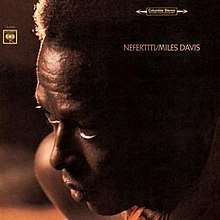Nefertiti (Miles Davis album)
Nefertiti is a studio album by American jazz musician Miles Davis, released in March 1968.[10] Recorded on June 7, June 22–23 and July 19, 1967, at Columbia's 30th Street Studio, the album was Davis' last fully acoustic album. Davis himself did not contribute any compositions, which were mostly written by Herbie Hancock and Wayne Shorter.[3]
| Nefertiti | ||||
|---|---|---|---|---|
 | ||||
| Studio album by | ||||
| Released | January 15, 1968[1] | |||
| Recorded | June 7, 22-23 and July 19, 1967 30th Street Studio (New York City) | |||
| Genre | ||||
| Length | 39:08 | |||
| Label | Columbia | |||
| Producer | Teo Macero, Howard Roberts | |||
| Miles Davis chronology | ||||
| ||||
| Review scores | |
|---|---|
| Source | Rating |
| Allmusic | |
| Down Beat | |
| Penguin Guide to Jazz | |
| Q | |
| The Rolling Stone Album Guide | |
| The Rolling Stone Jazz Record Guide | |
| Tom Hull – on the Web | A–[9] |
Music
The fourth album by Miles Davis's Second Great Quintet, Nefertiti, is best known for the unusual title track, on which the horn section repeats the melody numerous times without individual solos while the rhythm section improvises underneath, reversing the traditional role of a rhythm section.[3] C. Michael Bailey of All About Jazz cited it as one of the quintet's six albums between 1965 and 1968 that introduced the post-bop subgenre.[2]
Shortly after this album, Hancock recorded a different version of "Riot" for his 1968 album Speak Like a Child. In 1978, Shorter recorded a new version of "Pinocchio" with Weather Report for the album Mr. Gone.
This album, along with others by this particular group, demonstrates their willingness to fundamentally alter the basics of a composition during the recording process. For example, the quintet initially rehearsed 'Madness' as a slow waltz. On the next two takes (including the released version) it is rendered at a fast tempo in predominantly 4/4 time. Similarly, Pinocchio is a relatively fast composition on the released version and yet the group rehearsed it at a much slower pace, with the horns repeating the head whilst the rhythm section improvises underneath, in a similar manner to the master take of 'Nefertiti'.[11]
Nefertiti was the final all-acoustic album of Davis' career. Starting with his next album, Miles in the Sky, Davis began to experiment with electric instruments, marking the dawn of his electric period.[12]
Track listing
| No. | Title | Writer(s) | Recording session[1] | Length |
|---|---|---|---|---|
| 1. | "Nefertiti" | Wayne Shorter | June 7, 1967 | 7:52 |
| 2. | "Fall" | Wayne Shorter | July 19, 1967 | 6:39 |
| 3. | "Hand Jive" | Tony Williams | June 22, 1967 | 8:54 |
| No. | Title | Writer(s) | Recording session[1] | Length |
|---|---|---|---|---|
| 1. | "Madness" | Herbie Hancock | June 23, 1967 | 7:31 |
| 2. | "Riot" | Herbie Hancock | July 19, 1967 | 3:04 |
| 3. | "Pinocchio" | Wayne Shorter | July 19, 1967 | 5:08 |
| Total length: | 39:08 | |||
- Sides one and two were combined as tracks 1–6 on CD reissues.
| No. | Title | Writer(s) | Recording session[1] | Length |
|---|---|---|---|---|
| 7. | "Hand Jive" (First Alternate Take) | Tony Williams | June 22, 1967 | 6:50 |
| 8. | "Hand Jive" (Second Alternate Take) | Tony Williams | June 22, 1967 | 8:17 |
| 9. | "Madness" (Alternate Take) | Herbie Hancock | June 23, 1967 | 6:45 |
| 10. | "Pinocchio" (Alternate Take) | Wayne Shorter | July 19, 1967 | 5:08 |
| Total length: | 1:06:08 | |||
Personnel
Musicians
Production
- Teo Macero – production
- Howard Roberts – production
- Fred Plaut, Ray Moore – engineering
- Rob Schwarz – mastering
Chart history
Billboard Music Charts (North America) – Nefertiti[3]
- 1968: Top Jazz Albums – No. 8
References
- "Miles Davis – Nefertiti". milesdavis.com. Retrieved February 4, 2017.
- "Miles Davis – Nefertiti (CD)". Discogs. Retrieved February 4, 2017.
- "Nefertiti – All Music Review". All Music. Retrieved February 4, 2017.
- Frank Alkyer Enright; Jason Koransky, eds. (2007). The Miles Davis Reader. Hal Leonard Corporation. pp. 305–6. ISBN 1617745707.
- "Nefertiti – Acclaimed Music". acclaimedmusic.net. Retrieved February 4, 2017.
- "Review: Nefertiti". Q. London: 89. January 1992.
Acoustic jazz couldn't go far after this masterpiece...
- Considine, J. D.; et al. (November 2, 2004). Brackett, Nathan; Hoard, Christian (eds.). The New Rolling Stone Album Guide: Completely Revised and Updated 4th Edition. Simon & Schuster. p. 215. ISBN 0-7432-0169-8.
- Swenson, J., ed. (1985). The Rolling Stone Jazz Record Guide. USA: Random House/Rolling Stone. p. 58. ISBN 0-394-72643-X.
- Hull, Tom (n.d.). "Grade List: Miles Davis". Tom Hull – on the Web. Retrieved July 22, 2020.
- Carter, Ron; et al. (2012). Miles Davis: The Complete Illustrated History. Voyageur Press. p. 126. ISBN 0760342628. Retrieved July 20, 2013.
- Waters, Keith (2011). The Studio Recordings of the Miles Davis Quintet, 1965-68. Oxford: Oxford University Press. pp. 217–228. ISBN 9780195393835.
- "Rediscovering the Miles Davis Quintet". Slate. Retrieved February 4, 2017.
- "Miles Davis – Nefertiti (LP)". Discogs. Retrieved February 4, 2017.
- "Miles Davis – Nefertiti (CD)". Discogs. Retrieved February 4, 2017.